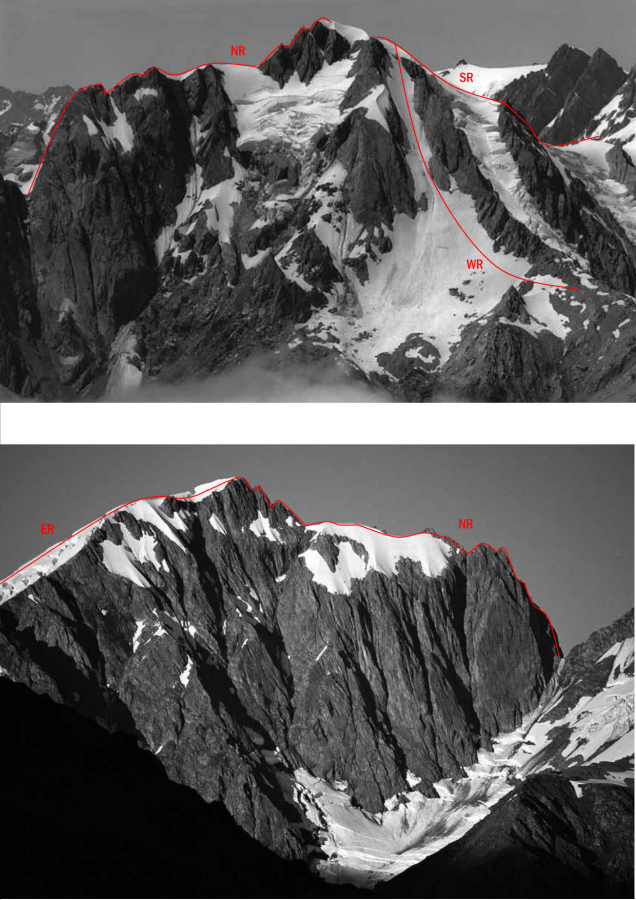There are also some significant unclimbed rock ribs off the North Ridge into both the Poerua and Alpheus Creek that would be worth investigating.
Routes
| Reference | Title | Grade | Length | Pro | Quality | Alert | Operations |
|---|---|---|---|---|---|---|---|
| West from Angel Col, (Kensington to The Great Unknown) | 0m | ||||||
The high snow plateau between Mts Hulka and Farrar can be accessed up crevassed snowslopes from Angel Col, but later in the season this route can get cut off. Alternatively, the Arethusa can be used for access, but this can get very difficult too. However, once on this plateau, Farrar, Hulka and Kensington are readily approached. Other peaks and cols in this block are accessible from the western end of the Garden of Eden, once referred to as the Western Lawn. Travel along this western section of the Garden of Eden can sometimes be a bit tight now under pt 2020m, where crevasses below and bits of ice debris from above sometimes meet, but it always remains travellable. |
|||||||
| SR | SRSouth Ridge from Iceland Col, 2 | 2 | 0m | ||||
|
Early in the season, this can be an easy snow climb from Iceland Col, but later on schrunds can increase difficulties. Alternatively, from the upper Arethusa, snowslopes lead up onto the east ridge which can be followed to the summit. Access up the Arethusa Icefall is getting increasingly difficult.
|
|||||||
| Adams Range Traverse, IV,2 | IV,2 | 0m | |||||
|
An alpine range traverse. Travel from 2194m through towards 2042m is easy. Beyond, the first traverse party reported interesting rock climbing in places, but continued to make steady progress along the range, reaching Barlow Saddle the same day. Rock was variable, with them cutting steps in loose steep schist rock at one point. Much of the range from pt 1528m to pt 1605m is tussock and short grass, and there are some wonderful campsites with tarns between pt 1576m and pt 1557m. A short section between pt 1557m and pt 1605m is exposed and loose in places, with small tussocky pinnacles. Beyond, the ridge broadens into gravel leading to the West Ridge of Kensington, where snow gullies lead through to the summit if required. Howitt and Gill fixed climbed a few hundred metres of the razorback rock ridge dividing the Poeroa from the Barlow before a 60m 'vertical razorback' forced them down onto the snow route up.
|
|||||||
| ER | EREast Ridge, 2 | 2 | 0m | ||||
A mix of rock and snow travel. The east ridge is easily approached from the upper Arethusa Glacier and travel on the upper section straight forward. |
|||||||
| WR | WRWest Ridge, 2+ | 2+ | 0m | ||||
|
From the Poerua-Barlow saddle (between pts 1576m and 1557m), easy walking on the ridge leads to about the 1900m contour where the ridge becomes razorbacked. The first ascent party climbed most of this before gaining a snow couloir and ascending that through to the summit.
|
|||||||
| NR | NRNorth Ridge, 3 | 3 | 0m | ||||
From the North Poerua Glacier sidle east past pt 2177m to the col under the buttress dividing Alpheus Creek from the South Poerua, or else reach here from Alpheus Creek itself. Snow gullies lead to the col from both sides in early summer, but watch for stonefall, especially on the Poeroa side. Above the col, the most difficult climbing is in the first 50m on sometimes loose and sometimes firm schist. The first ascent route climbed directly from the col, turning slabby bluffs a short way up out to climbers left in a shallow flaky corner and continued more or less directly up to the top of the buttress. Above, pt 2332m can be bypassed closeby on snow to the east. A snow arete then leads to the last series of steps. These have reasonable rock, but are still demanding and an alternative is to sidle on snowslopes to the west, returning directly to the summit. |
|||||||
in association with the Canterbury Mountaineering Club
